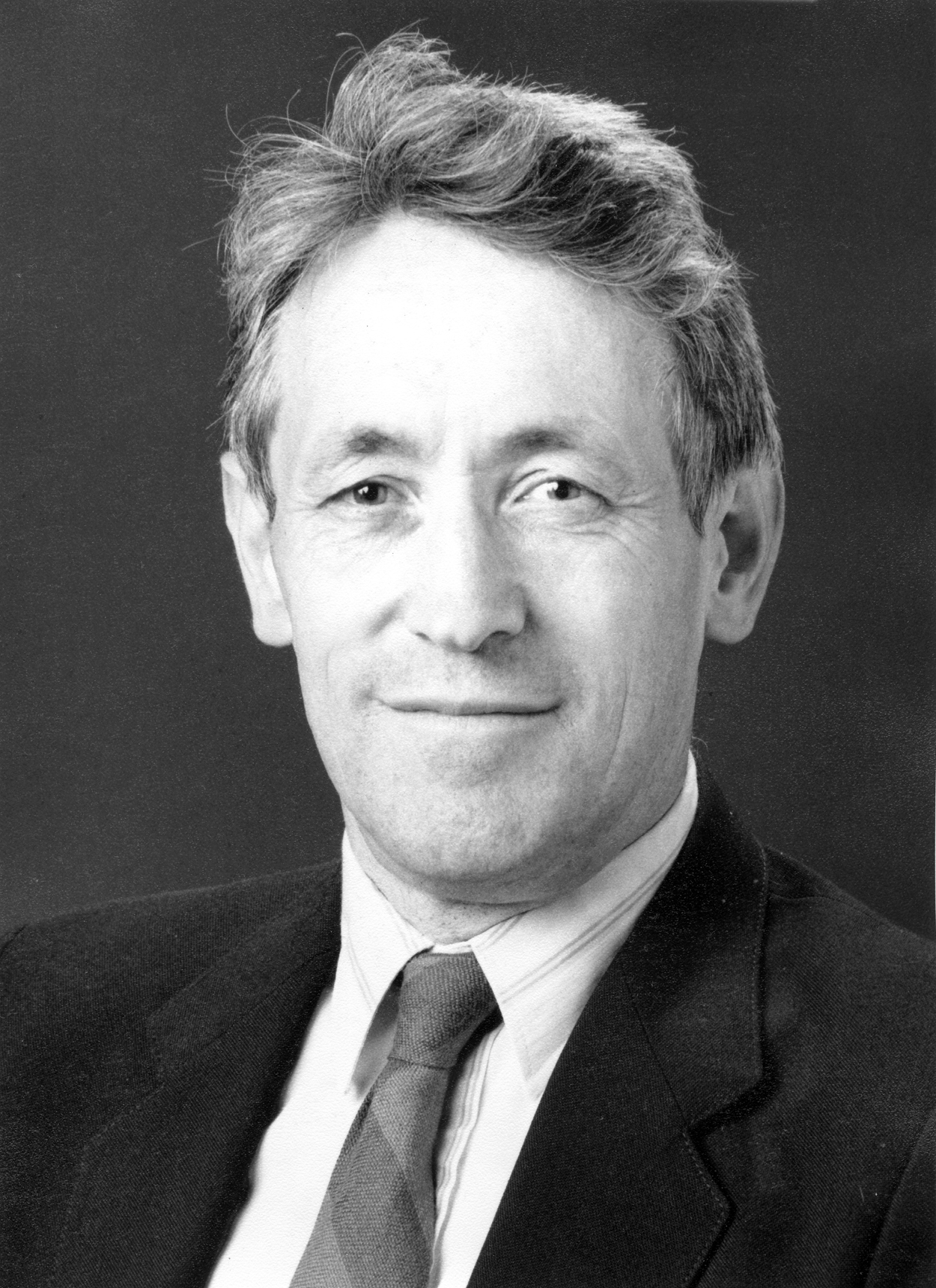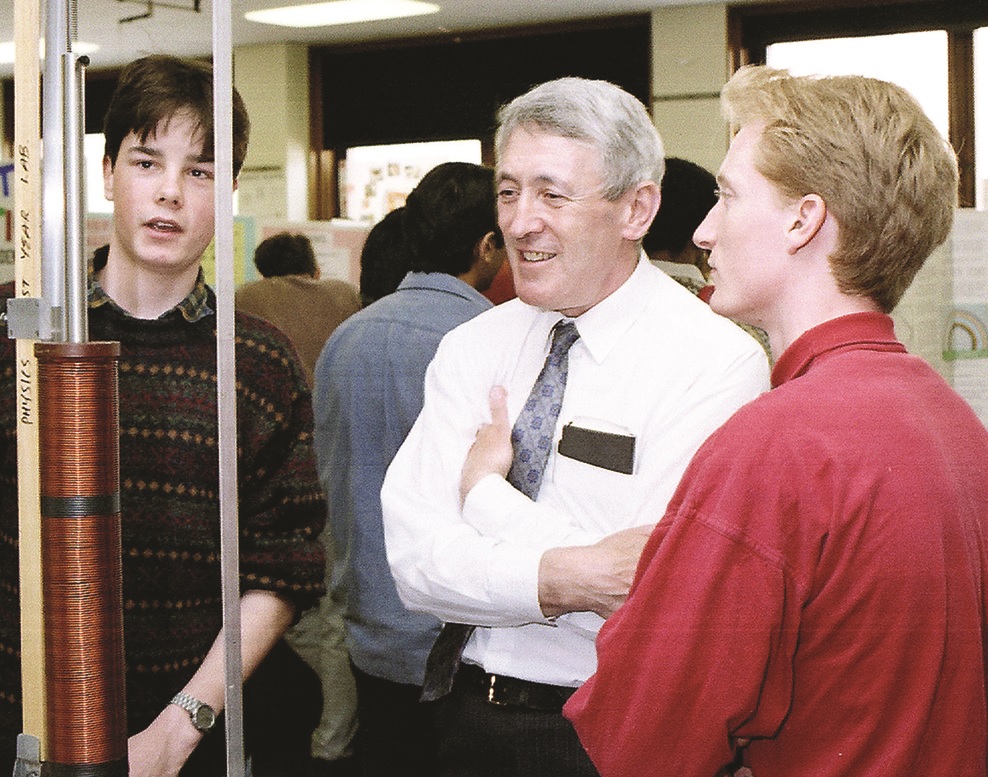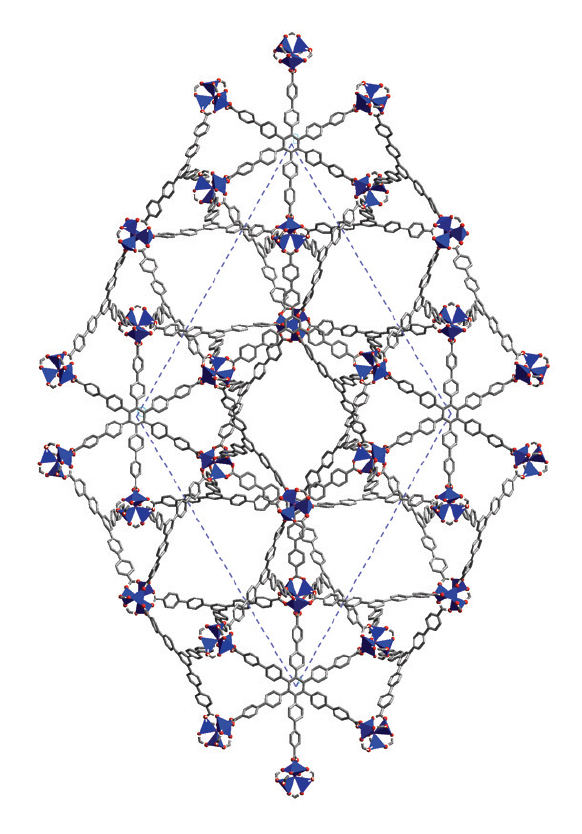- History Home
- People, Leadership & Service
- A Legacy of Excellence
- History & Impact
- Meetings Through the Years
- Resources
Obituary - David Blow (1931 - 2004)Obituary | Publications | Curriculum Vitae | Videos | Slides | Articles
David Blow (1931 - 2004)
A Remberance I was very fortunate to have pursued my doctoral studies under the direction of David Blow. Having heard of his untimely passing in June, and reading the many obituaries* writ- ten recently outlining his scientific achievements I felt compelled to share a few memories from the perspective of one of his former graduate students. Specifically I wanted to share the unique training environment David provided for myself and other graduate students that were part of his laboratory. I first met David at the IUCr meeting in Hamburg in 1984. Having not yet completed my MSc degree in small molecule crystallography, and wanting to move to the world of macro- molecular structure determination for my doctoral studies, I spoke with him about the possibility of joining his lab. I had been impressed with his outstanding work in the development of macromolecular phasing techniques, his work on the structure of chymotrypsin, which contributed significantly to understanding the catalytic mechanism of serine proteases in general, as well as his more recent work on structural studies of tyrosyl-tRNA synthetase. Our meeting left me with a strong impression of David as an excellent teacher and mentor and he encouraged me to join his group at Blackett Laboratory, Imperial College of Science and Technology in London. I could not have picked a better lab to pursue my doctoral studies! David was a very committed scientist who inspired many of us by the enormous passion and the enthusiasm he showed for his work. He was deeply committed to his students, not only striving to provide them with excellent training opportunities, but also creating an environment rich in learning and scientific interaction. His laboratory was endowed with highly skilled and committed postdocs and research associates possessing a wide range of skills in structural biology from important software developments such as the CCP4 suite of crystallographic software, still widely used by crystallographers around the world today, to the development of equipment used in crystallization (work in David’s lab ultimately led to the development of the IMPAX microbatch crystallization robot). Needless to say, being submerged in such an eclectic environment, built and supported by David, provided outstanding learning opportunities for a young gradate student such as myself. Furthermore, David strove to instill in all of his students a spirit of collaboration and a strong attitude of working together as a team. David’s early insight in the importance of creating such collaborative skills in his students have proven to be extremely important in today’s multidisciplinary world, particularly within biotech and pharmaceutical companies where crystallographers are constantly required to work within multidisciplinary teams. Although as PhD students we all managed our own projects, strong group interactions helped maximize our opportunities to learn from each other. Group meetings were always productive forums focused on methods to solve difficult issues. Morning coffee and afternoon tea times in our so-called “Interaction Room” also provided opportunities for stimulating conversations on the nuances of aspects of data processing, refinement and model building, not to mention critical discussions on new structures from recent journal articles which littered the coffee table. A most vivid memory of my initial months at Imperial College, and an outstanding example of David’s commitment to his students, included the first time I went to the synchrotron facility at Daresbury. Despite his extremely busy schedule, David took time to accompany us. I’m certain however that he saw these opportunities as welcome escapes from the more mundane paper- work tasks and thus an opportunity to do “real” science. During this trip, he instilled upon us the importance of working together during synchrotron runs. If your data was not being collected it did not mean that you went to sleep and waited for “your turn”. Rather your function was to provide as much assistance as possible to the person whose data was being collected in order to guarantee everyone a highly successful data trip. In addition, emphasis was placed on pursuing the highest quality data. For example, great pains were taken to ensure that the conditions for maximal quality data were achieved; time was spent fine tuning the configurations of data collection instruments in order to obtain the best data possible with the lowest noise levels. Also emphasis was placed on knowing your crystal morphology and using it to your advantage. Although many of these techniques are not used today (now we tend to shoot first and think later), I believe that the emphasis David placed on learning these fundamentals ultimately made us better crystallographers and gave us a more thorough understanding of the science. Furthermore, these values have provided me with a fundamental basis for critical thinking and an appreciation for the importance of detail in pursuing the best of possible results.
The lasting impact David had on his graduate students was perhaps most strongly felt and expressed when, in the summer of 2001, he celebrated his 70th birthday in Devon where he and his wife Mavis had retired. He organized and invited all his former graduate students and their families to a truly memorable two day reunion. Virtually all his surviving graduate students were in attendance (only Paul Sigler, David’s first PhD student, who sadly, had passed away only a short while before our reunion, was not in attendance). We had a wonderful opportunity to visit with David and Mavis and to enjoy each others company. Sadly, for many of us, this was the last time we would see David. Unforgettable to me, during this wonderful visit, were the accolades that were shared amongst us, of David’s contribution to molding each of our careers as scientists and teachers. Although he is no longer with us, the spirit of scientific endeavor, enquiry and enthusiasm that he instilled in us during these formative years of our careers will remain with us for the rest of our careers. - Alice Vrielink
The determination of the three-dimensional structure of proteins by x-ray crystallography was one of the critical developments in the explosive growth of biological sciences and the associated arrival of modern biotechnology since the 1950’s. David Blow was an undergraduate physics student in Cambridge in the early 50’s and made fundamental contributions both to the development of the methods used in crystallographic analysis of large biological molecules, and to solving the crystal structures of several key enzymes. After David’s graduation he found his way to Max Perutz in the Cavendish and studied crystallographic techniques that he and his mentor hoped would lead to a three dimensional structure of haemoglobin. This was not a popular or fashionable topic at the time. Indeed many doubted that proteins such as hemoglobin even had a unique structure and many conventional crystallographers wondered whether Perutz and Sir Lawrence Bragg (the Cavendish Professor), were wasting their time on frivolous pursuits. However, others saw Perutz as having a far wider appreciation of science than his critics. Indeed he had obtained funding from the Medical Research Council (MRC) and the Rockefeller foundation and was willing to give David a chance as a research student. It soon became apparent that Max Perutz’s little MRC unit had more potential than appearances suggested. For instance it housed Francis Crick and Jim Watson who spent their time talking and making the century’s most important biological discovery, namely the structure and function of DNA, the genetic basis of inheritance. David benefited greatly from this stimulating environment. It is not surprising that one of the important scientific contributions he made as a graduate student was described in a paper coauthored with Crick1 which showed how to minimize the effect of experimental errors in the calculation of protein electron density maps. David married Mavis Sears in 1955 while he was a graduate student. Two years later they left for America where David had been awarded a Fulbright travel grant and enjoyed a post-doctoral position in Alex Rich’s laboratory at NIH in Bethesda, close to Washington. Halfway through his stay in the US, Alex moved to MIT in Boston and David moved with him. Alex’s laboratory was in many ways an extension of the Cambridge experience for David in that Alex himself had been a frequent visitor to Cambridge and had become interested in the fiber diffraction techniques that had been used for the study of DNA. It was while David was spending two years in America that I joined Max’s unit. During my first year with Max we were able to obtain a low resolution structure of haemoglobin, while John Kendrew obtained a near atomic resolution structure of the related oxygen carrier, myoglobin. The evolutionary significance of these two related structures no doubt contributed greatly to the subsequent award of a Nobel prize jointly to Max and John. Although David missed these exciting times, they formed the basis of our joint work and both of our subsequent careers. When David returned to Cambridge in 1959 on Max’s invitation, he was given desk space in the same small room as I was already sharing with two other visitors. Whenever David or I sat down at our respective desks we invariably bumped into each other. But we bumped into each other in more than a physical way, for we quickly established a close friendship and intellectual collaboration. I discovered that David had a missionary Methodist background having been educated at the Kingswood School in Bath, which was originally founded by John Wesley. Indeed David’s background and my Quaker schooling had much in common. We were also at equivalent stages of our careers, having both spent two years as post-doctoral researchers in American laboratories before returning to England. In the next five years we wrote a series papers together which were to form the rudiments of much of protein crystallography, the technology that would provide in subsequent years the three dimensional atomic structures of tens of thousands of biological macromolecules. Such information has become essential for drug design by the pharmaceutical industry and is a major unifying topic in modern biology. But in those years that David and I worked closely together we had little idea of the future developments that would take off with exponential growth in the mid 80’s. David Harker2 had shown that it was necessary to have at least two isomorphous heavy atom derivatives to determine the phases of the native structure factors and the structure determinations of myoglobin and hemoglobin had used six or more difficult to prepare compounds. David (Blow) and I were able to show that one compound could be sufficient to obtain an interpretable map with a single isomorphous replacement (SIR) heavy atom derivative3. In the same paper we were able to show that the anomalous dispersion information for the single derivative (SAD) provided considerable additional power, even in the absence of the powerful intensity integration techniques used universally today. At about the same time we pointed out that there are convenient coefficients that can express the relationship between phase angle and phase probability and can be used to correctly combine a variety of phasing information4. In this paper we also analyzed the diminishing returns provided by each additional heavy atom derivative. The ideas of this paper were incorporated by Hendrickson and Lattman5 in their subsequent discussion of the same problem. Perhaps our most important contribution was the first paper on molecular replacement6 in which we introduced the concept of non-crystallographic symmetry (NCS) and derived an expression for the rotation function, which we tested on its ability to detect the similarity of the α and β chains of hemoglobin.
It had been David’s initiative to study the digestive enzyme, chymotrypsin, which he had learned about from another lifelong colleague, Brian Hartley whom he had met in the 1950s. For a number of years we did this work together, solving many of the technical problems that led to later success7. That work came to fruition8 two years after I left Cambridge for America, when David’s group solved the structure of what was then only the third or fourth protein structure and the second enzyme structure to be known. In the world of biology, David is probably best known for his contribution to the discovery of the catalytic ser-his-asp triad mechanism of serine proteases through his work on chymotrypsin. Similar mechanisms have since been found in a vast number of basic biological processes ranging from blood clotting to viral maturation. He was elected Fellow of the Royal Society in 1972, he received the Charles Leopold Meyer Prize of the French National Academy of Sciences in 1979 with (the late) David Phillips, the Israeli Wolf Prize for Chemistry in 1987 and was elected a Foreign Associate of the French Academy of Sciences in 1992. David left Cambridge in 1977 to set up a biophysics unit at Imperial College in London. Here his research group determined one of the first structures of a tRNA synthatase9, an enzyme that translates the three letter code of nucleic acids into one of the 20 amino acids that occur in proteins. He also initiated research on cholesterol oxidase, an enzyme that links steroid structure and chemistry to interactions with protein surfaces, and sucrose isomerase which is an enzyme important in the commercial production of invert sugar. The structures of both were soon solved. David also devoted time to fostering and encouraging research into protein crystallization, a critical but uncertain step in protein crystallographic technology. With the fame that David accrued on account of his scientific successes came responsibility. In 1991, he was reluctantly persuaded to be head of the Physics Department, a job that no true scientist is likely to enjoy. One of the important services that David gave to British science was to assist in the birth of the British Crystallographic Association of which he was president from 1984 to 1988. Prior to its existence, crystallographers in Britain had been narrowly organized by the Institute of Physics, a hold over from the time when the subject was considered primarily suitable for physicists. In contrast the now buoyant BCA spans physics, chemistry, biology and materials sciences. In due course David took early retirement, retreating to Devon in 1994, where he and Mavis long had family connections. He paid frequent, often weekly, visits to London writing a book modestly entitled An Outline of Crystallography for Biologists. He also wrote scientific reviews and took on numerous voluntary jobs for the benefit of other scientists. Although he was no longer deeply engaged in research, he remained much in demand as a lecturer, especially to give courses on x-ray crystallography. David’s scientific contributions and his enthusiasm for the subject gave these lectures authority and popularity. David will be remembered for his unique approach to research, his work on crystallographic methods, his contributions to the understanding of protein structure and enzyme mechanisms and his advice on dealing with the complex issues that arose as structural biology moved from being merely of academic interest to being central to the pharmaceutical industry. My last letter from David, shortly before his death, ended with “We shall both always remember the wonderful years when we worked together.” He is survived by his wife Mavis, his son Julian a biologist at the University of Dundee, his daughter Elizabeth, and their families including five grandchildren as well as many friends the world over. I thank Guy Dodson of the University of York and Richard Henderson of the MRC Laboratory of Molecular Biology in Cambridge for their help in writing this article. - Michael G. Rossmann Another version of this obituary was published in The Guardian. References 1. Blow D. M., F. H. C. Crick. 1959. The treatment of errors in the isomorphous replacement method. Acta Cryst. 12:794-802. 2. Harker D. 1956. The determination of the phases of the factors of non-centrosymmetric crystals by the method of isomorphous replacement. Acta Cryst. 9:1-9. 2. Blow, D. M., M. G. Rossmann. 1961. The single isomorphous replacement technique. Acta Cryst. 14:1195-1202. 4. Rossmann, M. G., D. M. Blow. 1961. The refinement of structures partially determined by the isomorphous replacement method. Acta Cryst. 14:641-647. 5. Hendrickson W. A., E. E. Lattman, 1970. Representation of phase probability distributions for simplified combination of independent phase information. Acta Cryst. B26:136-143. 6. Rossmann, M. G., D. M. Blow. 1962. The detection of sub-units within the crystallographic asymmetric unit. Acta Cryst. 15:24-31. 7. Blow, D. M., M. G. Rossmann, B. A. Jeffery. 1964. The arrangement of α-chymotrypsin molecules in the monoclinic crystal form. J. Mol. Biol. 8:65-78. 8. Matthews, B. W., P. B. Sigler, R. Hender- son, D. M. Blow. 1967. Three-dimensional structure of tosyl-a-chymotrypsin. Nature 216:652-656. 9. Bhat, T., D. M. Blow, P. Brick, J. Nyborg. 1982. Tyrosyl-tRNA synthetase forms a mononucleotide-binding fold. J. Mol. Biol. 158:699-709.
|



